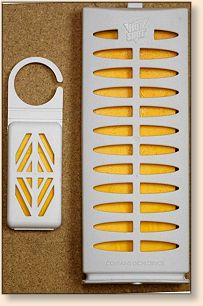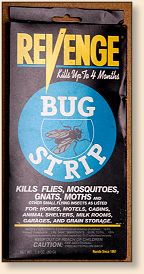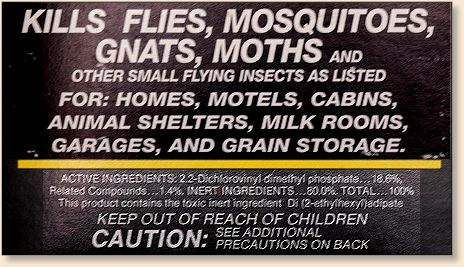|
It happens about once a month or so. You would
think we could get it done and over with, but it's
too big a problem for that. In fact, this is a
problem that could literally cost you hundreds if
not thousands of dollars if you don't get it fixed.
I suppose that's why so many people ask how to cure
it. The problem is bugs.
I'm not talking about common houseflies here. The
subject has nothing to do with biting insects. I'm
talking about those little beetles that will consume
your most costly fly tying materials in a matter of
a few days.
Actually, it isn't the beetles that do all the eating.
It's their larvae; and those little buggers can chew
up a hundred-dollar hackle cape in no time. You go
fishing for a few days and come back to find your
prized #1 cape (that you waited half a year to find)
downgraded to a pile of dust in the bottom of the bag
it was stored in. The only fingerprint the intruder
left behind is a bunch of small exoskeletons of the
larvae that were shed when they decided it was time
to become adults and spread their presence throughout
the rest of your tying stuff.
But you had the bag zipped shut, right? Look closely;
you'll find some tiny holes left behind by the adult
who laid the eggs that became the gluttons who ate
you out of fly tying materials. You'll also see the
holes the little buggers left as they left this bag
to find new lunch prospects. Heavy plastic bags only
slow them down a little, but they won't keep them out.
For many years, I used mothballs in an attempt to keep
the critters away from my stash. When the bugs managed
to make it past my defenses, I increased the treatment,
thinking that maybe I hadn't used enough. Eventually,
I got the dosage heavy enough to be smelled throughout
the house. Sitting for an extended period of time in
the fly tying room brought about periods of wheezing
and caused my eyes to water. However, I went a few
years without a bug infestation.
Then, one day I went to get some prized wood duck
flank feathers from their sealed plastic container,
and found a pile of dust mixed in with the mothballs.
How did they do that? I could barely breath after I
opened the container; the smell of mothballs was so
strong. But, the bugs must have designed some sort
of gas mask or became resistant to the smell. The
only thing I'm certain about is the fact that they
got past the mothballs and had a feast.
Next I tried moth crystals. No doubt about it,
those were extra strong. My wife threatened to
throw my whole stash out on the lawn if I didn't
do something about that smell. People were asking
us if we were wearing new clothes because they could
smell the fumes on our clothing. In the meantime,
bugs managed to munch down a prized golden pheasant
skin I had stored in a sealed Tupperware container
packed with crystals. Huh, that didn't work.

In desperation, I contacted an entomology professor
at the college. He was a fly tier and fully
understood my problem. He said mothballs and crystals
are more of a repellant than a bug killer. What he
thought I needed was something that would kill the
bugs on contact, or better yet, whenever they got
even close to my tying stuff it would be a terminal
approach. His suggestion? Flea collars. He said
flea collars didn't just repel bugs; they killed
them. Then he went on to say that I should also
consider something called a No-Pest strip, claiming
that locked inside a plastic container they would
keep me bug free for years without a replacement.
I gave the flea collar route a test on a couple of
pheasant skins I knew had the beginnings of an
infestation. Yup, flea collars kill bugs. In fact,
they kill bugs without the nasty fumes mothballs
give off. A year later, and a dozen flea collars
spread about in bits and pieces throughout my fly
tying stuff resulted in a zero infestation count.
However, flea collars cost quite a bit too. I
went on a grand search for No-Pest strips.
 It seems that Shell (the company who created the
first No-Pest strip) had discontinued manufacture
of the things. The rumor was that some kids had
ingested (does that mean ate?) some of the strips
and it nearly killed them. I guess I can understand
that a little bit. Outside their cardboard or plastic
sleeves, they look a lot like one of those all-day
caramel suckers. However, there were other strips
with several similar names that promised to do the
same thing. I bought them, cut them into chunks
and placed them in every fly tying material
container I had. I also hung one in each closet I
had fly tying stuff stored in.
It seems that Shell (the company who created the
first No-Pest strip) had discontinued manufacture
of the things. The rumor was that some kids had
ingested (does that mean ate?) some of the strips
and it nearly killed them. I guess I can understand
that a little bit. Outside their cardboard or plastic
sleeves, they look a lot like one of those all-day
caramel suckers. However, there were other strips
with several similar names that promised to do the
same thing. I bought them, cut them into chunks
and placed them in every fly tying material
container I had. I also hung one in each closet I
had fly tying stuff stored in.
For the last 16 years, the only bug proofing I have
used has been chunks of those strips. I replace the
strips in the closets at least once a year and throw
the used strips in with any new fly tying stuff I
have accumulated. After a year in a closet, those
strips still pack a heavy punch. If I open the box
I used an old strip in, even after just a few days,
I can smell the slight aroma of a bug-killing strip.
So far, I have never had to replace a strip in a
sealed box. Sixteen years later they still kill
bugs dead.
Possibly the best feature about pest strips is what
they do to the feathers and furs they are stored
with. Whatever the magic ingredient in those strips
is, it works its way into the feathers and fur and
seems to make them deadly to bugs. So deadly in
fact, that two summers ago I watched a housefly
land on a hackle cape I was using, and it didn't
survive to fly away. That cape had been outside
of its plastic box for about a week, and it was
still deadly to a bug. More recently I learned
that the stuff in pest strips is sometimes used
by taxidermists to bug-proof expensive mounts.
Must be some good stuff.

I buy my pest strips in small and large sizes at
local hardware and building supply stores. I know
Ace and Lowes carry them, and a local chain called
Menards has them. One pest strip costs about half
as much as a flea collar, and will treat about five
times as much space. I call that a bargain; and my
wife has decided my fly tying stuff can stay in the
house now. No heavy fumes, no burning eyes, and no
bugs.
Just in case you need another Testimonial, Castwell
has also been using them 'forever' no bugs there
either. ~ AC
|





